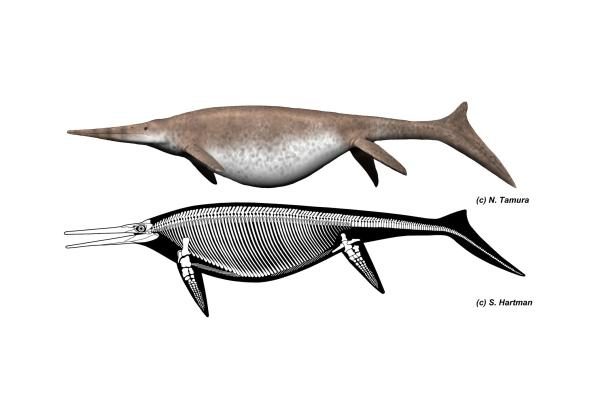Biology textbook have long touted the modern blue whale as the largest animal that ever lived, but this and other fascinating fossil finds hint that there may once have been even bigger creatures swimming Earth's seas.
What is this animal?
Ichthyosaurs were ocean-going contemporaries of the dinosaurs, with body shapes superficially similar to dolphins. They reached their greatest diversity about 210 million years ago in the late Triassic, but some persisted into the late Cretaceous. They vanished from the fossil record about 25 million years before the mass extinction that wiped out the non-avian dinosaurs.
Most ichthyosaurs were much smaller than the newly discovered creature-several species in the genus Ichthyosaurus also found in the U.K. were just 5 to 11 feet long. (See a 13-foot-long Jurassic ichthyosaur found in Scotland.)
How did paleontologists find it?
Self-taught fossil hunter and study coauthor Paul de la Salle was combing the beach at Lilstock, Somerset, in May 2016 when he found a large and puzzling chunk of fossil bone. Suspecting it might be an ichthyosaur, he sent images to marine reptile experts Dean Lomax at the University of Manchester in the U.K. and Judy Massare at SUNY Brockport in New York.
Further searching revealed five fossil pieces that fitted together to form a 3.2-foot-long bone, which the scientists identified as being from the lower jaw of an ichthyosaur. Based on the size of the bone, the scientists think this ichthyosaur was bigger than any previously known to science.
How did they figure that out?
Lomax and Massare travelled to Alberta, Canada, to examine the much more complete fossil of Shonisaurus sikanniensis, a 69-foot-long ichthyosaur found in 2004. Comparing the new fossil to the same bone in the jaw of Shonisaurus revealed that the new bone is 25 percent bigger. Scaling up the animal's full body gave the team their 85-foot size estimate. (Paleontologists also recently found a remarkably complete 16-foot ichthyosaur in India.)

Lomax says the discovery has led them to reinterpret a whole series of isolated bones found near the village of Aust in Gloucestershire, England. Some collected as early as 1850, these fragments had long been interpreted to be the limb or other bones of terrestrial dinosaurs, but this never quite made sense.
The scientists realized these pieces also belonged to giant ichthyosaurs-and possibly to ones even bigger than the newly identified animal.
"We compared it with these Aust bones, and as soon as I saw it in person, my jaw just hit the floor," Lomax says. "I realized this was a giant ichthyosaur and the biggest thing ever found in the U.K."
Darren Naish, a paleontologist at the University of Southampton in the U.K., agrees that the sizes of all these bones are astounding. He is part of a different team that recently examined the Aust bones and similarly concluded that they belonged to enormous ichthyosaurs.
He concurs with the size estimates of the study authors, and says that these animals were "approaching or exceeding various giant baleen whales in size."




We sat about 30 - 50 feet from them for 15 minutes, then we started paddling back in to the beach, whereupon they followed us in like a mama dog and puppy. When they got about 50 feet from the jetty, the mom flopped over and the baby started nursing.
If we did it now,. we'd both be arrested. Silly but true.
While she was 48 feet, we feared not for were weren't plankton. I dare say I'd get out of the water for the above critter.
R.C.